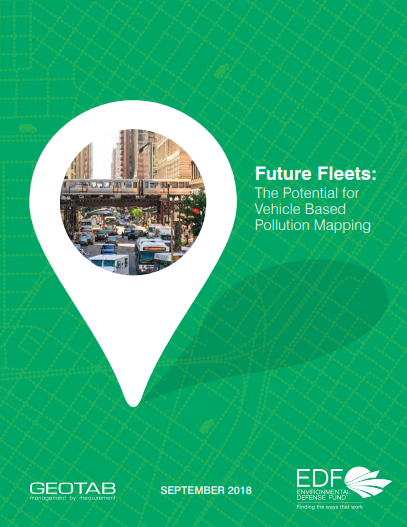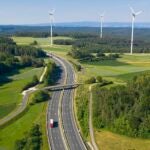- Resources
- Future fleets: how clean air innovations are driving smarter, healthier cities
Resources
Future fleets: how clean air innovations are driving smarter, healthier cities
Published: September 24, 2018 by EDF Staff
When you picture a city bus, an animal control van or a waste management truck, you’re probably not thinking about a high-tech, mobile urban sensing platform, about saving millions of lives, or about the smart city of the future. At least not yet. But a new initiative in Houston is turning public fleets into the rolling eyes and ears of the city, and enabling these vehicles to revolutionize the way air pollution is monitored, measured and ultimately addressed across the United States.
The information generated by these IoT-enabled “future fleets” is also a key tool in the transformation to fully connected, smarter cities, where hyperlocal data makes streets safer and less congested and where market forces reward urban efficiency, decarbonized electricity, and clean transportation. Picture using connected, clean fleets to improve delivery times, bring residents to work, school and doctor’s appointments, and even pinpoint the location of toxic air pollution threats all at the same time.
These vehicles are enabling a future where air pollution forecasts eliminate hundreds of thousands of heart attacks, tens of thousands of hospital and ER visits, and an even larger number of missed school and workdays that are caused annually by air pollution. Air pollution also costs the global economy $225 billion dollars every year in lost labor income, but recent studies show that improving air quality both indoors and outside could improve worker productivity.
The promise of vehicle-based pollution mapping

A new report reveals that by combining mobile air quality sensors with connected vehicle technologies think Dash, OnStar, and in this case Geotab, which co-authored the report with Environmental Defense Fund (EDF) city vehicles in particular could measure air pollution at an unprecedented scale. The report explains that just 10 to 20 vehicles could, without changing their regular routes, map 50 to 70 percent of a city.
Today, air pollution is measured by stationary monitors that are often dispersed miles apart, and located atop buildings far away from the air that people actually breathe. This infrastructure is insufficient for getting adequate information on the true nature of air pollution, which EDF, Aclima, the University of Texas at Austin, and Google’s work in Oakland, California showed can be as much as eight times higher on one end of the block than the another.
As the chief environmental science officer for the city of Houston has noted, improving our ability to measure air pollution will improve our ability to manage it and real-time information, mobile monitoring is going to change the playing field.
Smart fleets on the ground in Houston

Houston residents, like in many other cities across the U.S. and around the world, have expressed concern about air pollution and the associated health effects. After some hard-won improvements in air quality over the last two decades, progress has plateaued, and there is a lot more work to do to bring Houston’s air into compliance with the federal government’s health-based standards.
But if we can solve the air pollution problem in Houston, we can solve it anywhere. I’m encouraged that Houston’s leadership is taking action: Mayor Sylvester Turner is the co-chair of Climate Mayors, a group of leaders supporting the goals of the Paris Agreement, and Houston is working to decarbonize its own fleet.
Now, Houston is working with EDF and Geotab to deploy “future fleets” across the city: low-maintenance air pollution monitoring systems installed atop city vehicles, self-powered, and can handle wind, heat and rain. The system includes tailored Aethlabs black carbon sensors and particulate sensors, which are matched with telematics technologies that offer location, speed, and other data. With telematics, information can be aggregated, anonymously, across multiple fleets to create maps that pinpoint the exact locations of pollution hotspots.
Why hyperlocal insights matter
The implications of this initiative are near limitless. In a state with so much wind energy that electricity can be free at night, Houston has the opportunity to use hyperlocal insights to target clean transportation strategies for health, resiliency, and even climate since the sources of air pollution and climate change emissions are often the same. In other words, smart climate change strategies can provide health co-benefits, and smart health strategies can also protect the planet.
As Geotab’s VP of data and analytics Mike Branch noted, “If air pollution sensors are factored into cities’ transition to electric fleets, the amount of hyperlocal data at our fingertips would be unprecedented.” The same would be true if companies like Ikea, which is shifting to a zero emissions delivery fleet, helped fix air pollution hotspots first, and incorporated sensors into their electric vehicle transition.
Accelerating clean air innovations
But before businesses and communities reap the benefits that hyperlocal data can bring and before checking air pollution forecasts becomes as second nature as checking your email in the morning we will need more and better air pollution sensing technologies and services and the ability to integrate, access and analyze the data from multiple sources. We also need better decision tools to enable public and private leaders to integrate potential health benefits into their climate action plans.
To companies including IBM, AT&T, Cisco and Google and the other tech giants that are receiving praise for their good work in innovating urban environments, I thank you. But I also know that air pollution cannot be truly understood at scale without your help. That is why announcements such as Google’s Environmental Insights Explorer should be celebrated for what it already does, and for what it could do if it integrated health impacts into sustainability planning.
I welcome your collaboration in creating new sensing platforms, new ways to integrate data, and new ways to make decisions that turn data into action. This innovation would help cities and companies around the world protect health and the climate, and walk the walk on your sustainability commitments.
Follow Aileen on Twitter.

